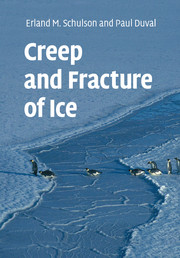Book contents
- Frontmatter
- Contents
- Preface
- Acknowledgements
- 1 Introduction
- 2 Structure of ice
- 3 Microstructure of natural ice features
- 4 Physical properties: elasticity, friction and diffusivity
- 5 Plastic deformation of the ice single crystal
- 6 Ductile behavior of polycrystalline ice: experimental data and physical processes
- 7 Modeling the ductile behavior of isotropic and anisotropic polycrystalline ice
- 8 Rheology of high-pressure and planetary ices
- 9 Fracture toughness of ice
- 10 Brittle failure of ice under tension
- 11 Brittle compressive failure of unconfined ice
- 12 Brittle compressive failure of confined ice
- 13 Ductile-to-brittle transition under compression
- 14 Indentation fracture and ice forces on structures
- 15 Fracture of the ice cover on the Arctic Ocean
- Index
- References
7 - Modeling the ductile behavior of isotropic and anisotropic polycrystalline ice
Published online by Cambridge University Press: 01 February 2010
- Frontmatter
- Contents
- Preface
- Acknowledgements
- 1 Introduction
- 2 Structure of ice
- 3 Microstructure of natural ice features
- 4 Physical properties: elasticity, friction and diffusivity
- 5 Plastic deformation of the ice single crystal
- 6 Ductile behavior of polycrystalline ice: experimental data and physical processes
- 7 Modeling the ductile behavior of isotropic and anisotropic polycrystalline ice
- 8 Rheology of high-pressure and planetary ices
- 9 Fracture toughness of ice
- 10 Brittle failure of ice under tension
- 11 Brittle compressive failure of unconfined ice
- 12 Brittle compressive failure of confined ice
- 13 Ductile-to-brittle transition under compression
- 14 Indentation fracture and ice forces on structures
- 15 Fracture of the ice cover on the Arctic Ocean
- Index
- References
Summary
Introduction
During the gravity-driven flow of glaciers and ice sheets, isotropic ice at the surface progressively becomes anisotropic with the development of textures. Strain-induced textures, combined with the strong anisotropy of the ice crystal, make the polycrystal anisotropic. A polycrystal of ice with most of its c-axes oriented in the same direction deforms at least ten times faster than an isotropic polycrystal, when it is sheared parallel to the basal planes. Depending on the flow conditions, this anisotropy varies from place to place. To construct ice-sheet flow models for the dating of deep ice cores, this evolving viscoplastic anisotropy must be taken into account. Computation with isotropic and anisotropic flow models predicts at depth an age of ice that can differ by several thousand years. From Mangeney et al. (1997), anisotropic ice could be more than 10% younger above the bumps of the bedrock and could be older by more than 100% within hollows. An adequate constitutive relationship must be also incorporated within large-scale flow models to simulate the variation of polar ice sheets with climate.
Various models have been proposed to simulate the evolution of the anisotropy and the behavior of such ices. The increasing numerical capability of computers and the advances in theories that link materials' microstructures and properties have enabled the development of new concepts and algorithms that constitute the so-called multiscale approach for the modeling of material behavior. In this chapter, we restrict our analysis to physically based micro-macro models using a self-consistent approach.
- Type
- Chapter
- Information
- Creep and Fracture of Ice , pp. 153 - 178Publisher: Cambridge University PressPrint publication year: 2009



